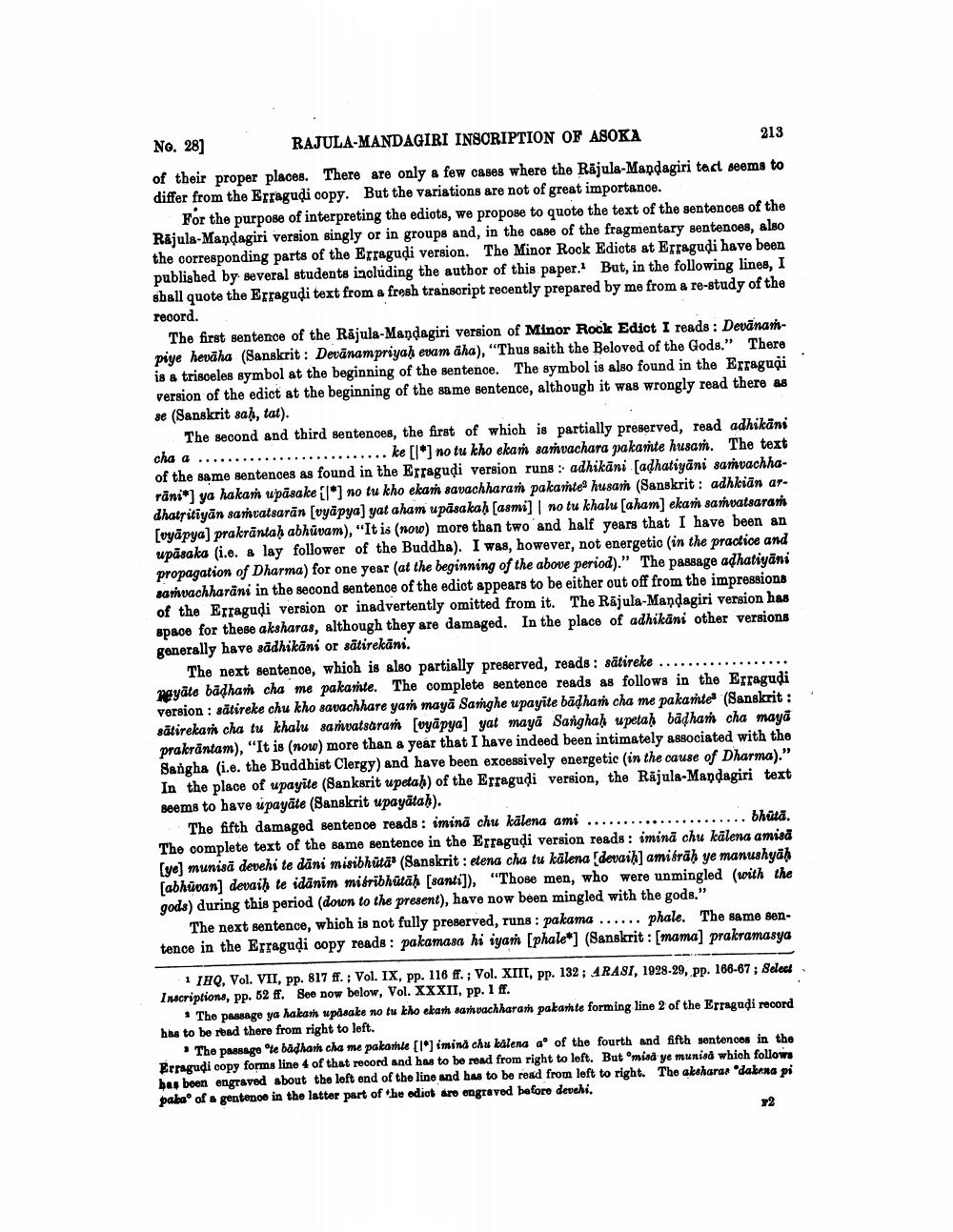________________
No. 28]
RAJULA-MANDAGIRI INSCRIPTION OF ASOKA
213
of their proper places. There are only a few cases where the Rajula-Mandagiri text seems to differ from the Erragudi copy. But the variations are not of great importance.
For the purpose of interpreting the ediots, we propose to quote the text of the sentences of the Rajula-Mandagiri version singly or in groups and, in the case of the fragmentary sentences, also the corresponding parts of the Erragudi version. The Minor Rock Edicts at Erragudi have been published by several students including the author of this paper. But, in the following lines, I shall quote the Erragudi text from a fresh transcript recently prepared by me from a re-study of the record.
The first sentence of the Rajula-Mandagiri version of Minor Rock Edict I reads: Devanampiye heväha (Sanskrit: Devanampriyah evam aha), "Thus saith the Beloved of the Gods." There is a trisceles symbol at the beginning of the sentence. The symbol is also found in the Erraguai version of the edict at the beginning of the same sentence, although it was wrongly read there as se (Sanskrit saḥ, tat).
The second and third sentences, the first of which is partially preserved, read adhikāni cha a ...... ke [*] no tu kho ekam samvachara pakamte husam. The text of the same sentences as found in the Erraguḍi version runs adhikāni [adhatiyani samvachharāni*] ya hakam upasake [*] no tu kho ekam savachharam pakamtes husam (Sanskrit: adhkiän ardhatritiyān samvatsaran [vyäpya] yat aham upasakaḥ [asmi] | no tu khalu [aham] ekam samvatsaram [vyapya] prakrāntaḥ abhuvam), "It is (now) more than two and half years that I have been an upāsaka (i.e. a lay follower of the Buddha). I was, however, not energetic (in the practice and propagation of Dharma) for one year (at the beginning of the above period)." The passage adhatiyani samvachharani in the second sentence of the edict appears to be either out off from the impressions of the Erragudi version or inadvertently omitted from it. The Rajula-Mandagiri version has space for these aksharas, although they are damaged. In the place of adhikāni other versions generally have sädhikāni or satirekāni.
The next sentence, which is also partially preserved, reads: satireke.....
Mayate badham cha me pakamte. The complete sentence reads as follows in the Erraguḍi version: satireke chu kho savachhare yam maya Samghe upayite badham cha me pakamtes (Sanskrit: satirekam cha tu khalu samvatsaram [vyapya] yat maya Sanghaḥ upetaḥ badham cha maya prakrāntam), "It is (now) more than a year that I have indeed been intimately associated with the Sangha (i.e. the Buddhist Clergy) and have been excessively energetic (in the cause of Dharma)." In the place of upayite (Sankarit upetah) of the Erragudi version, the Rajula-Mandagiri text seems to have upayate (Sanskrit upayātaḥ).
The fifth damaged sentence reads: imina chu kalena ami
bhūtā.
The complete text of the same sentence in the Erraguḍi version reads: imina chu kalena amisä [ye] munisă devehi te däni misibhütä (Sanskrit: etena cha tu kalena [devaih] amiérāḥ ye manushyaḥ [abhuvan] devaiḥ te idānīm misribhūtāḥ [santi]), "Those men, who were unmingled (with the gods) during this period (down to the present), have now been mingled with the gods."
The next sentence, which is not fully preserved, runs: pakama...... phale. The same sentence in the Erragudi copy reads: pakamasa hi iyam [phale*] (Sanskrit: [mama] prakramasya
1 IHQ, Vol. VII, pp. 817 ff.; Vol. IX, pp. 116 ff.; Vol. XIII, pp. 132; ARASI, 1928-29, pp. 166-67; Select Inscriptions, pp. 52 ff. See now below, Vol. XXXII, pp. 1 ff.
The passage ya hakam upasake no tu kho ekam samvachharam pakamte forming line 2 of the Erragudi record has to be read there from right to left.
The passage te badham cha me pakamie [1] imina chu kalena a of the fourth and fifth sentences in the Erragudi copy forms line 4 of that record and has to be read from right to left. But misa ye munisă which follows has been engraved about the left end of the line and has to be read from left to right. The aksharas "dakena pi paka of a gentence in the latter part of the edict are engraved before devehi.
12




